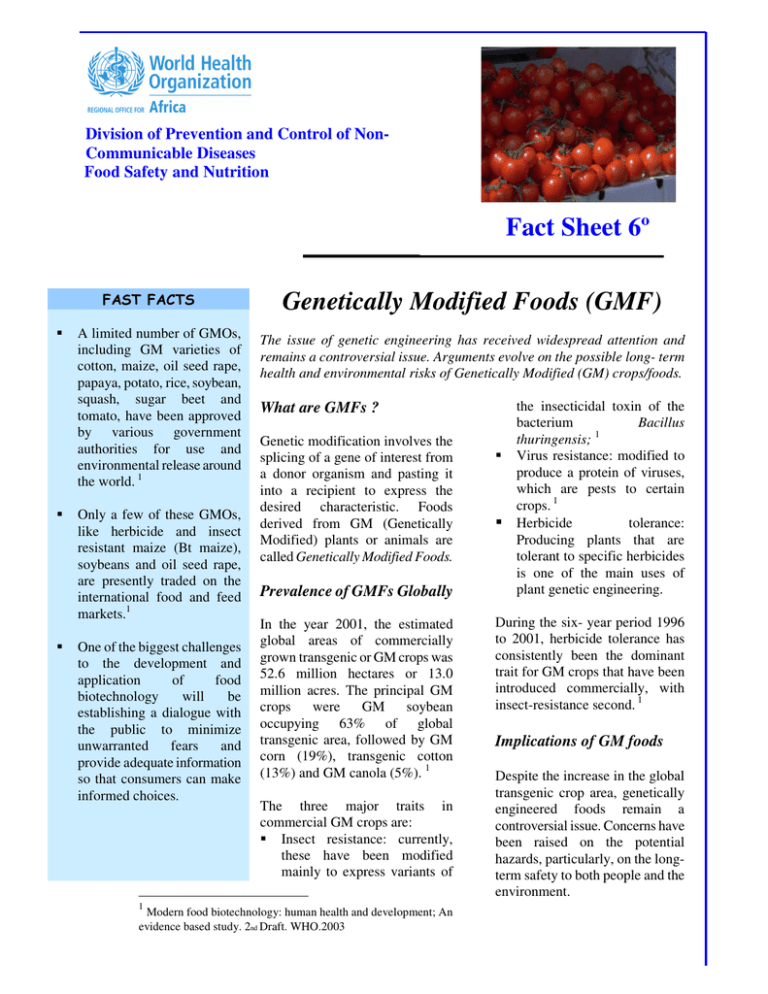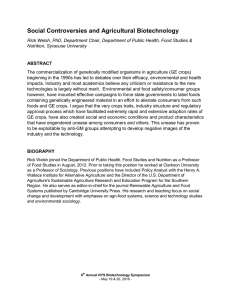GMF - Regional Office for Africa
advertisement

Division of Prevention and Control of NonCommunicable Diseases Food Safety and Nutrition Fact Sheet 6º FAST FACTS Foodborne Many foodborne diseases diseases and are A limited number GMOs, widespread pathogenic microorganisms and ofrepresent including varieties of significant are spread GM threats by contaminated to health cotton, maize, oil seed rape, and economies of countries. hands. papaya, potato, rice, soybean, squash, sugar beet and • Foodborne It is estimated pathogens, that more such than tomato, have been approved 70% as salmonellosis, of the approximate shigellosis, 1.5 by various government billion episodes hepatitis A, giardiasis of diarrhoea and authorities for use and that occur in the world campylobacteriosis are environmental release around annually 1are transmitted via thecaused faecal-oral by the world. biological route. These or account chemical for a contamination substantial number of foods. of disease Only a few of these GMOs, outbreaks in developing like herbicide and insect countries. • A survey report from the resistant maize (Bt maize), WHO African Region soybeans and oil seed rape, indicated thatdrinking-water 45 countries • Good quality are presently traded on the havegood and proposed personal food hygiene control in international food and feed legislation, but only and 13 food 1preparation markets. countries have enacted any handling are therefore of utmost importance in laws. 1 One of the biggest challenges preventing the spread of to the development and disease.1 application of food biotechnology will be establishing a dialogue with the public to minimize unwarranted fears and provide adequate information so that consumers can make informed choices. • 1 Genetically Modified Foods (GMF) The issue of genetic engineering has received widespread attention and remains a controversial issue. Arguments evolve on the possible long- term health and environmental risks of Genetically Modified (GM) crops/foods. What are GMFs ? Genetic modification involves the splicing of a gene of interest from a donor organism and pasting it into a recipient to express the desired characteristic. Foods derived from GM (Genetically Modified) plants or animals are called Genetically Modified Foods. Prevalence of GMFs Globally In the year 2001, the estimated global areas of commercially grown transgenic or GM crops was 52.6 million hectares or 13.0 million acres. The principal GM crops were GM soybean occupying 63% of global transgenic area, followed by GM corn (19%), transgenic cotton (13%) and GM canola (5%). 1 The three major traits in commercial GM crops are: Insect resistance: currently, these have been modified mainly to express variants of Modern food biotechnology: human health and development; An evidence based study. 2nd Draft. WHO.2003 the insecticidal toxin of the bacterium Bacillus thuringensis; 1 Virus resistance: modified to produce a protein of viruses, which are pests to certain crops. 1 Herbicide tolerance: Producing plants that are tolerant to specific herbicides is one of the main uses of plant genetic engineering. During the six- year period 1996 to 2001, herbicide tolerance has consistently been the dominant trait for GM crops that have been introduced commercially, with insect-resistance second. 1 Implications of GM foods Despite the increase in the global transgenic crop area, genetically engineered foods remain a controversial issue. Concerns have been raised on the potential hazards, particularly, on the longterm safety to both people and the environment. Some environmental concerns of GM crops: Unintended transfer of transgenes through cross-pollination. Unknown effects on other organisms (e.g., soil microbes) and loss of flora and fauna biodiversity. characteristics and plants or animals producing pharmaceutically important proteins such as vaccines. Challenges Some food safety and Health concerns: The direct consequences (e.g. nutritional, toxic or allergenic effects) of the presence in foods of new gene products encoded by genes introduced during genetic modification. The consequences of gene transfer to gastrointestinal microflora from ingested genetically modified foods or food components derived from them. The potential adverse health effects associated with genetically modified food microorganisms. Human health safety aspects of GM foods One of the biggest challenges to the development and application of food biotechnology will be establishing a dialogue with the public to minimize unwarranted fears and provide adequate information so that consumers can make informed choices. In the field of potential risks derived from out-crossing or contamination of GM crops safety relevant consequences need to be investigated specifically for specific crops and strategies for risk management need to be explored. WHO technical support and actions on foods derived from biotechnology The Regional office in collaboration with WHO headquarters will make available and disseminate to countries findings of expert consultations on foods derived from biotechnology. No specific international regulatory systems for GM food safety are currently in place. However, several international organizations are involved in developing safety assessment protocols for GMOs. 1 The potential risks associated with GMOs and GM foods have to be assessed on a case by-case basis taking into account the characteristics of the GMO or the GM food and possible local differences of the receiving environment. 1 Future Developments GM products currently being developed include fruits, vegetables and cereals. It is reported that other future potential applications of genetic modification could result in crops with increased nutrient levels, reduced reliability on chemicals – herbicide tolerant and disease and pest resistant plants, fish species with enhanced growth For More Information on Food Safety and Nutrition please contact Division of Prevention and Control of Noncommunicable Diseases (DNC). B.P. 6 Congo, Brazzaville.

